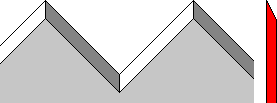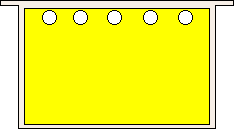Beekeeping Tools
|
|
|---|
|
Beekeeping Tools |
Apple Corer for making holes in foundation |
|---|

An apple corer is a domestic kitchen tool that can be modified in order to make a tool for cutting holes in beeswax foundation, to achieve faster drawing of comb by the bees and save wax.
This tool can be found in most households being used for its correct purpose, but if it has its teeth sharpened with a fine toothed file, it will easily cut holes in fresh foundation.
| Sharpening the teeth on the inside of the tube, in the fashion indicated will also enable it to perform its original function more swiftly and with a cleaner cut. |

|
|---|
|
Why poke holes in new foundation? Is the indignant question that often follows my statement, but it is good for various reasons and actually speeds up the process of comb drawing by allowing the bees to communicate during the early stages, when normally they would be separated by a solid wall of foundation. The holes allow the clustering bees to communicate with one another which gives them a more stable sense of community (my surmise, backed by observation), it also allows easy passage at several points for bees to traverse from one side of the growing comb to the other. |

|
|---|
Five years after writing the original page, I came across the article reproduced below that was written by Arthur Dines and published in Bee Craft, June 1971 edition. Please consider the date of writing when reading the text as the cover price of the magazine was £0.07 with postage at 2 1/2 pence!
The Price Of HolesBuy foundation at £1 per lb, cut holes in the sheets and sell the bits that come out as scrap wax. Sounds daft! All right then, let the manufacturer supply us with perforated foundation, with more sheets per pound. A good idea ? We do not know yet, but it might be. Several years ago a Slovakian scientist found out that bees would very quickly draw out sheets of foundation which had holes in them, and that provided the holes were not above a certain size the spaces would be filled perfectly with worker cells. In his experiments he found that up to 30% or 40% of the total area could be so removed. Some of us here are trying out the idea this summer, are you willing to have a go? Although it seems that round holes did not give the maximum economy, these are by far the simplest to make. Some sort of sharp-edged metal tube, used like a housewife's pastry cutter, does the job. The maximum recommended diameter is 30 mm, to be on the safe side say one and one eighth inches in our funny old measurements. Such things as aluminium containers for medical preparations could be sources for such a tool. Mr. Ashwin, of Robertsbridge, Sussex, has found the ideal punch. An ordinary light bulb that has spent its normal life has the glass broken away, the brass rim that was around the bulb base is just the right size. Quite seriously, the B.B.K.A. Research Committee thinks that a mass experiment among ordinary beekeepers on this idea might prove to be valuable. We want a thousand people to try it out; will you be one? Let us know your results, tell us what size of hole used, how many per sheet, under what conditions, brood combs or supers, and add any other information you think might be useful. The Convenor of the Committee expects a thousand letters before the end of the season. Send them to:- A.M. Dines. |
Dave Cushman.
Page created 20/01/2002
Printed from Dave Cushman's website Live CD version
Written... 20 January 2002, New Domain... 05 February 2004, Upgraded... 11 August 2004, Further Upgraded with additions... 05 April 2007, Upgraded... ... 06 December 2007,
|